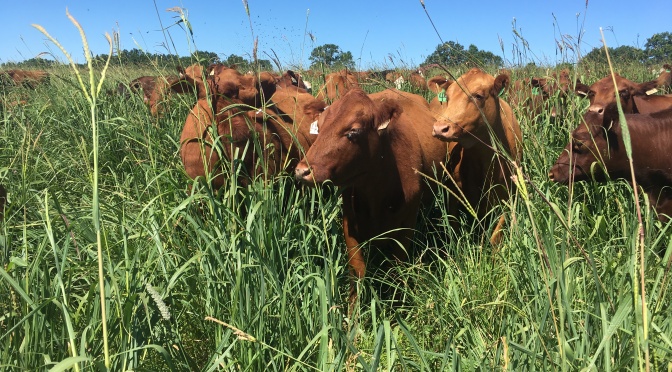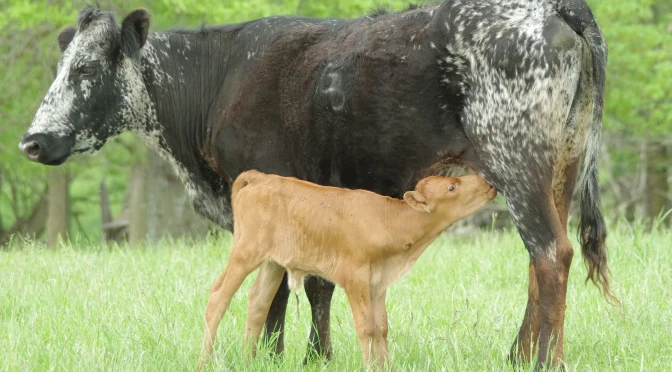Heather Smith Thomas has written an interesting article for Progressive Cattle magazine entitled, “Fall Calving – Worth the Off-Season Plunge?“. It’s worth a read for consideration, however, in my opinion, the answer is given in the question. Seldom, if ever, doing anything off -season is smart or profitable.
The advantages listed in the article are straw man arguments, however, so if you are considering changes to your heard, be certain to talk to producers who can show you the real costs.
So, while it’s a good article – you must do your own research. As you see, i easily refute all the ‘advantages’ listed in the article of fall calving in my own operation and resource base. I like to be profitable and fall calving simply doesn’t fill the bill. (Disclaimer – my husband has a spring and fall calving herd and he likes it that way)
Another thing to remember when reading articles is that many producers call spring calving Dec through Feb/Mar. That is the dead of winter! Spring starts March 20. Fall calving would mean starting September 20. Make sure you clarify what people actually mean when these terms are bandied about.
Dr. George Barrington, Washington State University, says the advantages and disadvantages to fall calving are partly geographic, with regional and management differences. “Some producers in the Intermountain West have successful fall-calving programs, even though it might work best in a milder climate,” he says.
Advantages
The benefits of fall calving include a chance for better prices when fall-born calves are sold the next spring or summer. More people are spring-calving, with a larger supply of calves in the fall at weaning time, so the market generally drops. There is more demand for calves marketed in the spring.
Dr. Shelie Laflin has a mobile veterinary practice and helps run the family ranch and registered Angus herd near Olsburg, Kansas. Her family has both a spring- and fall-calving herd, and she prefers fall calving. “Several studies have shown that fall calving generally gives a better return for your investment. Cows tend to breed back sooner because they’ve been on a better nutritional plane through summer rather than having just come through winter before calving, and also tend to have less dystocia when they calve,” says Laflin.
Cows that come through cold during pregnancy tend to have heavier birthweight calves. “Cows that are pregnant in warm weather tend to have slightly smaller calves at birth – on average – and fewer dystocia cases compared to calves with the same genetics and management born in the spring,” says Laflin. “This means less labor needed, less stress on calves, healthier calves, with less scours and pneumonia, and fewer cases of mastitis in the cows.”
However, if cows are calving on mature grass pasture in the fall, calves sometimes get umbilical infections from grass awns getting up into the umbilical cord stump. “In the spring, umbilical infections are usually due to mud and dirty conditions,” she says.
There is no perfect situation. “From a management standpoint, however, from calving up until calves are about 2 months old, fall is hands down better than spring, especially in terms of illness.” By the time those calves are 2 months old, they are less vulnerable to some of the common diseases and can also withstand cold weather.
“Fall calving might mean from early or mid-September until late November,” says Barrington. “If producers are doing any farming, spring is usually a very busy time, and fall tends to have fewer demands on time and labor. Some producers in eastern Washington prefer fall calving because they also grow wheat. They are so busy in the spring that they can’t devote time to calving,” he says.
“We spend a lot of time treating calves for diarrhea in the spring – in wet, muddy confined areas. If weather does not allow producers to put the cows in larger, clean areas to calve, they are usually calving on the winter feeding area in contaminated conditions,” says Barrington. There are often better options in the fall for where the cows can calve.
“We calve fairly late in the fall,” says Laflin. “We are busy with haying until early September. There might be some producers harvesting crops in the fall – putting up the last of the hay and ready to start cutting corn or other crops. There might be overlap with harvesting and calving, but fieldwork overlap can also be a problem if a producer is calving in April/May,” she says.
“For us, the labor becomes a big factor. We are a family operation, and our kids play a big role in what we do. The labor involved in spring calving is just more intensive, trying to manage baby calves in cold weather. We feed the cows a lot through cold weather, and they tend to produce bigger calves and also make more milk than young calves can consume – which can lead to scours, mastitis, etc.”
Regarding vaccination, fall- and spring-calving herds are managed the same, but since there is less risk for scours in fall-calving cows, they may not need pre-calving vaccinations for scours. With fall calvers, this would be one less time those cows have to go down the chute. Those are late-gestation vaccinations, and most people would rather not stress their cows at that time if they don’t have to.
“From a bull management standpoint, there isn’t much difference, but the nice thing if you run two herds, is the opportunity to spread out your bull power and decrease your cost per calf,” says Laflin. Fewer bulls are needed because they can manage both breeding seasons with a period of rest in between.
Disadvantages
“Some of the disadvantages of fall calving in certain climates is that grass is maturing and going dormant,” says Barrington. “In the Southeast, however, there may be new growth of grass, and fall-calving cows have good nutrition.” At higher elevations and northern regions, fall rains might bring a brief flush of green grass, but dropping temperatures soon end the growing season. Cows generally must be fed through winter, and lactating cows have higher nutrient demands.
“We sometimes have lighter weaning weights with fall-born calves,” says Laflin. “Those calves are born at a time when we soon have to supplement the cows. Many fall-calving herds in our area start in September and are done by Thanksgiving, and by then, our native grasses are dry and dormant, and we need to supplement. There is an increased cost in feed, but several studies show that even with the increased cost, over the years, you will fare better with the fall calving compared with spring calving,” says Laflin.
“All of this must be penciled out, looking at the amount and quality of feed that will be needed,” says Barrington. “You lose all the advantages of fall calving if the cows aren’t producing milk or if it costs too much to feed them. Fall calves may also be a little lighter at weaning than spring-born calves because they went into winter soon after birth and require more feed for maintenance and body heat. Small calves are not yet ruminants, so they are not producing body heat from fermentation in the rumen.” 
Heather Thomas is a freelance writer based in Idaho.
Determining which season to use
There is no perfect calving season. “Ranches with both a spring- and fall-calving herd have the best chance to weigh benefits and disadvantages for their own environment, management, labor availability and feed,” says Dr. George Barrington. They can compare, within their split herd, to see which season pencils out best when figuring feed costs, etc.
- Weather is a big factor and it can be variable from year to year. “If someone wants to try fall calving, they should not base a decision on just one year’s experience. The more data you can get, the better decisions you can make,” says Barrington. The year you try fall calving might be really good or really bad – for weather, or calf prices, etc., but that year might not be typical.
- Feed inputs are something to think about. “If you are buying most of your feed, it will cost more, especially if you need to push first-calf heifers nutritionally to get them to cycle back again,” says Dr. Shelie Laflin. “You’ll have to put some feed into them because your native grass is gone, dormant or snowed under, whereas in the spring, the grass is coming on lush, and this will flush the cows for cycling.”Cows grazing new green growth breed better, and a person might not have to buy as much feed. However, you are also feeding calves through winter until weaning in April. In a spring-calving herd, you are only feeding cows through winter, rather than pairs.
- Health: On the other hand, wintering calves with their mothers has some advantages. They tend to stay healthier through winter than calves weaned in late fall just before going into winter. We run fall and spring calves – about half and half – and our fall calves have fewer problems. There is less labor involved, and the calves wean off better. We don’t have to deal with disease at weaning time; they’ve already come through winter.” By contrast, the spring-born calves are weaned in October, and it’s starting to get cold, and weather can be bad.





